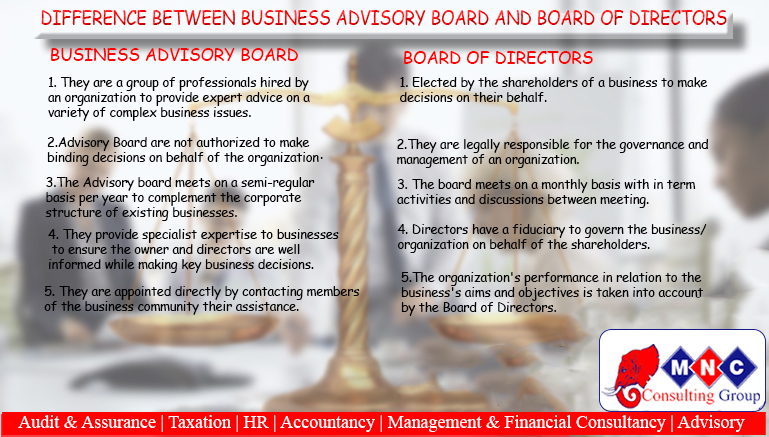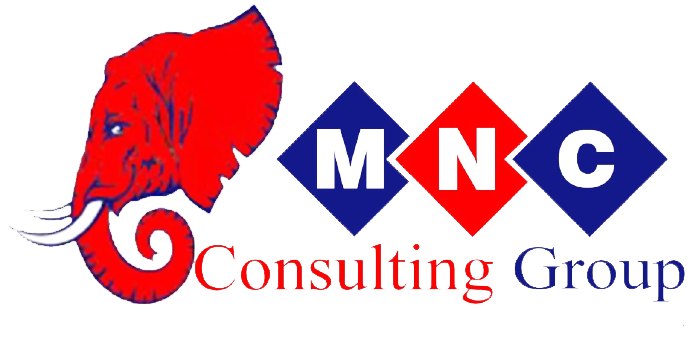[vc_row][vc_column][vc_custom_heading source=”post_title” use_theme_fonts=”yes”][vc_column_text]What is a Business Advisory Board (BAB)?
A Business Advisory Board is a group of local business and community leaders who are recruited by the owners of the business to serve as mentors.
Key role of a Business Advisory Board (BAB)
- Providing guidance and mentorship
- Introducing the entrepreneur to other business leaders in the community
- Suggesting project ideas
- Providing access to needed resources
- Funding opportunities
- Giving feedback on projects and presentation
Difference between Business Advisory Board (BAB) and Board of Directors (BoD)

Size of the BAB
An effective BAB should consist of around 5 to 8 members. Greater numbers are acceptable, but a minimum of 6 would be needed to ensure a range of organizations are represented; a range of specific and general management skills are represented; and gender diversity is represented.
Factors to consider when determining the size of a BAB
- Manageability
- Budget
- Sustainability
- Quorum
- Diversity
- Responsibility
- Skills requirement
Sector representation of members of the BABs
- Members of leading businesses, educational and civic organization
- Members of the organization sponsoring the business/company
- Members of the Mass Media
- Institutional administrators
- Religious organizations
- Members of various professional bodies
- Representative from political arena
- Local managers from national and/or State businesses
- Managers from local industry associations
Skills requirements for BABs
BAB members will be most effective if they can bring some or all of the following skills to the team.
- General management
- Specific technical skills e.g. marketing, finance, IT, HR etc
- Project management
- Mentoring
- Any specific skills required by projects eg scientific, theatrical, media etc
Frequency of meeting of BABs
- Meetings should be held on a quarterly basis at minimum – anything less and there may not be enough contact between members to ensure the BABs effectiveness. New BABs may wish to hold more frequent meetings at first.
- BAB members can be invited to participate in other events such as networking socials, presentation practices, and various project-related events.
- Subcommittees should meet more frequently.
Required level of commitment expected from BAB members
BAB members are requested to:
- Make themselves available for meetings wherever possible.
- Be willing to provide constructive mentoring, coaching and guidance to teams and individual team members where applicable.
- Provide feedback to their organization on their activities as a BAB member.
- Be willing to provide in-kind and/or financial support where possible.
- Suggest possible projects.
Tips to maintain a satisfactory level of commitment from BAB members:
- Be clear about expectations right from the onset through the BAB Member Handbook and initial discussions.
- Hold a begging of the year meeting to review your plans for the new year and introduce new members of the board.
- Schedule meetings and events as early as possible to increase attendance. It also helps if meetings are scheduled on a certain day, such as the first Thursday of the month.
- Record action items in the minutes of each meeting and be sure to follow up with those responsible for their completion.
- Establish a term (between one and three years) for BAB members to serve so they know they have a finite period to provide support and commitment to the team.
- Ensure open communication with BAB members so that they still feel “in the loop” even if they miss a meeting or an event.
- Share links to your team website and social media pages.
- Encourage committee members to take the lead, but make sure their goals are realistic and compatible with your program’s mission.
- Establish and maintain a structure that works for everyone.
- Seek out new members and provide a thorough orientation for those who join.
- Provide regular updates about your program and let members know how their work has helped you progress toward your goals.
- Ask for opinions or involvement only when it fits with the group’s mission and role as advisors.
- Thank members regularly in many different ways in person, in handwritten notes, via e-mail, in your newsletter for the work they are doing.
Cost of running a BAB
The amount of money required is relative and depend with the amount allocated in the budget for the following purpose:
- Printing (e.g. for invitation packages)
- Facility rental
- Refreshments and/or lunch (for meetings or other BAB events)
- Appreciation gifts (e.g. at Christmas)
- Sitting allowance (Not Compulsory)
Steps for developing an effective BAB
- Obtain approval from your board of directors or other governing body to establish.
- Establish the purpose and scope of the group (increase feasibility, offer informed input, keep engaged with the community).
- Recruit members that fit with the group’s purpose.
- Build your team and develop structure.
- Prepare members for their role and the work they will do for your program (orientation, review mission, clarify extent and limit of authority).
- Empower the group to develop a clear scope of work:
- Facilitate a conversation about which program areas would benefit from the group’s support, such as volunteer recruitment and training, fundraising, or community awareness.
- Discuss which of the identified areas need support right now and which could wait or need little support.
- Have the group establish measurable objectives and specific activities for the areas they identify and a lead person for each area of involvement the committee plans.
Best practices for advisory board creation and success
Homework: Give the Advisory Board members simple ways to get ready for the meeting: e.g., reading a succinct brief on a problem to be discussed or going into the market to get smart about the context of a category to be presented. Share the questions you plan to ask so advisors have time to think about issues and back up their responses with examples, if possible.
Preparation: Executives who manage the Advisory Boards within a company are critical to its success. Preparing the agenda as well as the teams who participate and following up are critical if ideas are to turned into action.
Presentations: Presentations should be well edited, free of jargon, concise and designed to stimulate thinking rather than get buy-in. Questions are more important than answers.
Participation: When the intention is to spark new thinking that translates into the real activities of the company, it is critical that team leaders and key “doers” are equally represented in the room. The richness of the thinking and conversation at an Advisory Board meeting are as important as the actual recommendations. Leadership needs to be in sync with those who will be expected to take action.
Advice for recruiting members of BAB
Don’t offer equity
Offering equity in exchange for advice doesn’t incentivize a potential advisor to join your advisory board. Giving away part of your company deters a prospective member
Don’t propose on the first date
It’s not yet time to make this a formal arrangement. If you want to get someone to join your BAB, just ask the person a question first. Get on a quick call with person. Have a conversation and see if person actually has valuable advice for you.
Make it easy for a person to say yes to you by asking a straightforward question, rather than asking for continuous involvement. Initiate the relationship with a small, non-committal step, rather than formalizing the relationship early.
Be concise
A great advisor values his/her time, and so should you. Don’t send long email which are no conclusive. Try to provide the relevant information with the least amount of words. You can just add a sentence to your email: “I know your time is valuable, so I’m being succinct. If you want more context around any of these points, I’ll gladly share it with you.”
Got good advice? Share your results!
If you benefited from the advice you are given – tell the person about it. The most rewarding thing for many advisors is seeing people put their advice to use and succeed with it. (Which is a surprisingly rare occurrence – most people never act on the advice they get, but instead do what they already thought was right).
Here’s one way how you could send an update and take the next step to building a relationship.
Hey firstname,
Hope this mail finds you well. Thanks again for sharing some advice with me last week/month. I’ve done X (like you suggested) and it’s really improved our Y (e.g. we’ve increased conversions from trial to customer by k% and gotten a lot of positive feedback).
Now I’m wondering how to ___, would love to chat with you about this Wednesday 4pm or Thursday 2:30pm PT. Let me know if we can put something in our calendar.
Kind Regards,
Senders Name
Keep it short, use clear language, be positive and appreciative.
The Ask-Get-Use-Share Cycle of Advice
You basically want to run through this cyclus repeatedly, starting small and growing over time:
- ask for advice
- get advice and express thanks
- put the advice to use
- share the results, and ask for the next piece of advice.
The more often you go through this cycle, the more invested your advisor will become in your success and the more this relationship will grow.
When is the right time to make a formal offer?
After both sides have consistently engaged in and nurtured this relationship for a meaningful period (could be six months, one or two years), then it’s a good idea to formalize the relationship and offer equity or other incentives.
About the Author
Thank you for reading this article. The author, James Ndambiri is an avid Business Advisor and Consultant: A Tax Surgeon, Proficient Accountant, Skilled Auditor, a Guru in Financial and Investment management, Expert in Business Strategy Formulation, Business Transformation Wizard, Family Business Advisor, Lecturer, Business Coach and a Family Man.
James is the Founder, Team Leader, CEO & Managing Partner of MNC Consulting Group. MNC Consulting Group is your most trusted and respected professional business consulting firm recognized by our clients for delivering excellent business advisory and consulting services that create value to their ventures. With our focus set on value addition, we offer our clients the highest quality professional services in Accounting, Audit and assurance, Tax, Business Transformation, Investments and Financial Advisory, Family Business Advisory, Company Secretarial Services and Property Management that addresses their business needs through attracting, recruiting and retaining knowledgeable and passionate professionals who enable us to deliver superior results while contributing positively to the community in which we live and work.

Make us your business partner by always consulting with us.
‘‘With us, you are in safe hands’’[/vc_column_text][/vc_column][/vc_row]
